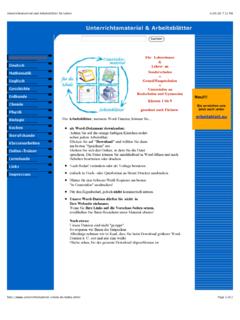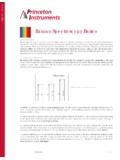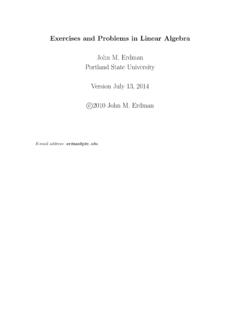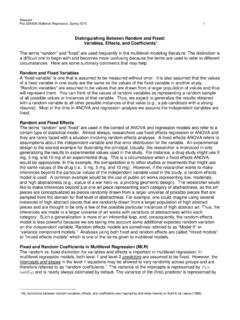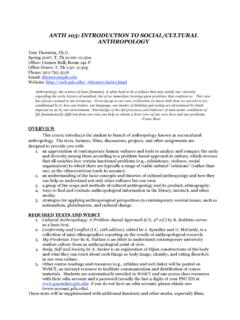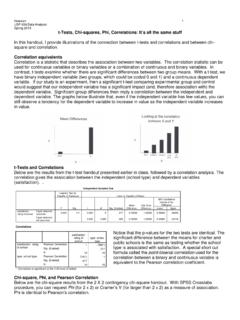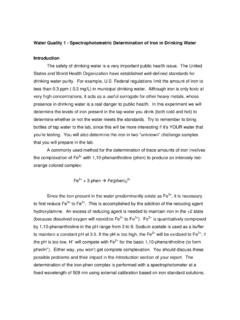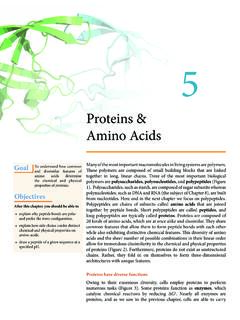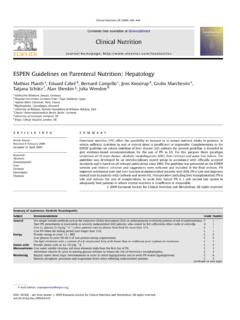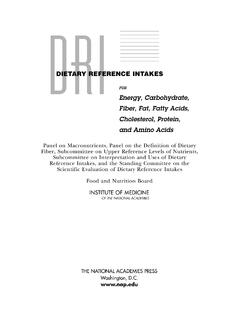Transcription of WADEMC24 1153-1199hr.qxp 16-12-2008 14:15 Page 1153 24
1 16-12-2008 14:15 Page 1153. C H A P T E R COO . 24. a-h eli amino ACIDS, x PEPTIDES, AND NH. 3. PROTEINS. Proteins are the most abundant organic molecules 24-1. in animals, playing important roles in all aspects of cell structure and function. Proteins are biopolymers of Introduction A- amino acids, so named because the amino group is bonded to the a carbon atom, next to the carbonyl group. The physical and chemical properties of a protein are determined by its constituent amino acids. The individual amino acid subunits are joined by amide linkages called peptide bonds.
2 Figure 24-1 shows the general structure of an a- amino acid and a protein. carbon atom O. H2N CH C OH. - amino group R side chain an - amino acid O O O O O. H2N CH C OH H2N CH C OH H2N CH C OH H2N CH C OH H2N CH C OH. CH3 CH2OH H CH2SH CH(CH3)2. alanine serine glycine cysteine valine several individual amino acids peptide bonds O O O O O. NH CH C NH CH C NH CH C NH CH C NH CH C. CH3 CH2OH H CH2SH CH(CH3)2. a short section of a protein FIGURE 24-1. Structure of a general protein and its constituent amino acids.
3 The amino acids are joined by amide linkages called peptide bonds. 1153. 16-12-2008 14:15 Page 1154. 1154 CHAPTER 24 amino Acids, Peptides, and Proteins TABLE 24-1. Examples of Protein Functions Class of Protein Example Function of Example structural proteins collagen, keratin strengthen tendons, skin, hair, nails enzymes DNA polymerase replicates and repairs DNA. transport proteins hemoglobin transports O2 to the cells contractile proteins actin, myosin cause contraction of muscles protective proteins antibodies complex with foreign proteins hormones insulin regulates glucose metabolism toxins snake venoms incapacitate prey Proteins have an amazing range of structural and catalytic properties as a result of their varying amino acid composition.
4 Because of this versatility, proteins serve an as- tonishing variety of functions in living organisms. Some of the functions of the major classes of proteins are outlined in Table 24-1. The study of proteins is one of the major branches of biochemistry, and there is no clear division between the organic chemistry of proteins and their biochemistry. In this chapter, we begin the study of proteins by learning about their constituents, the amino acids. We also discuss how amino acid monomers are linked into the protein polymer, and how the properties of a protein depend on those of its constituent amino acids.
5 These concepts are needed for the further study of protein structure and function in a biochemistry course. 24-2 The term amino acid might mean any molecule containing both an amino group and any type of acid group; however, the term is almost always used to refer to an a- amino Structure carboxylic acid . The simplest a- amino acid is aminoacetic acid , called glycine. Other common amino acids have side chains (symbolized by R) substituted on the a carbon and Stereochemistry atom. For example, alanine is the amino acid with a methyl side chain.
6 Of the a- amino Acids O O O. H2N 9 CH2 9 C 9 OH H2N 9 CH 9 C 9 OH H2N 9 CH 9 C 9 OH. R CH3. glycine a substituted amino acid alanine (R CH3). Except for glycine, the a- amino acids are all chiral. In all of the chiral amino acids, the chirality center is the asymmetric a carbon atom. Nearly all the naturally occurring amino acids are found to have the (S) configuration at the a carbon atom. Figure 24-2. shows a Fischer projection of the (S) enantiomer of alanine, with the carbon chain along the vertical and the carbonyl carbon at the top.
7 Notice that the configuration of (S)-alanine is similar to that of L-1-2-glyceraldehyde, with the amino group on the left in the Fischer COOH CHO COOH. C C C. H2N CH3 HO CH2OH H2N R. H H H. COOH CHO COOH. FIGURE 24-2. H2N H HO H H2N H. Almost all the naturally occurring amino acids have the (S). CH3 CH2OH R. configuration. They are called L- amino acids because their L-alanine L-( )-glyceraldehyde an L- amino acid stereochemistry resembles that of (S)-alanine (S)-glyceraldehyde (S) configuration L-1 -2-glyceraldehyde.
8 16-12-2008 19:28 Page 1155. 24-2 Structure and Stereochemistry of the a- amino Acids 1155. projection. Because their stereochemistry is similar to that of L-1 - 2 -glyceraldehyde, the Bacteria require specific enzymes, naturally occurring (S)- amino acids are classified as L- amino acids. called racemases, to interconvert D. Although D- amino acids are occasionally found in nature, we usually assume the and L amino acids. Mammals do not amino acids under discussion are the common L- amino acids. Remember once again use D amino acids, so compounds that the D and L nomenclature, like the R and S designation, gives the configuration of that block racemases do not affect the asymmetric carbon atom.
9 It does not imply the sign of the optical rotation, 1 +2 or mammals and show promise as 1 - 2, which must be determined experimentally. antibiotics. amino acids combine many of the properties and reactions of both amines and carboxylic acids. The combination of a basic amino group and an acidic carboxyl group in the same molecule also results in some unique properties and reactions. The side chains of some amino acids have additional functional groups that lend interesting properties and undergo reactions of their own.
10 24-2A The Standard amino Acids of Proteins The standard amino acids are 20 common a - amino acids that are found in nearly all proteins. The standard amino acids differ from each other in the structure of the side chains bonded to their a carbon atoms. All the standard amino acids are L- amino acids. Table 24-2 shows the 20 standard amino acids, grouped according to the TABLE 24-2. The Standard amino Acids Functional Group Isoelectric Name Symbol Abbreviation Structure in Side Chain Point side chain is nonpolar, H or alkyl glycine G Gly H2N CH COOH none H.
